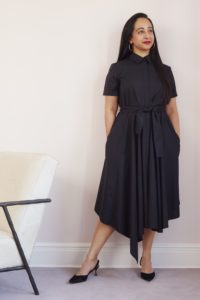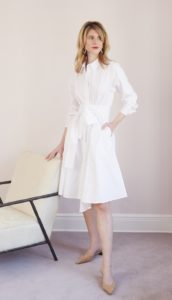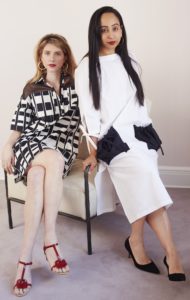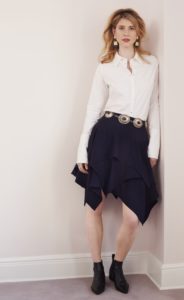Book Lists
Gift Guides
Reinventing the Way Clothes Fit
2662 New York offers chic, luxury looks that fit real women’s bodies
Sponsored by 2662 New York

Let’s face it. Shopping stinks. Magazines, the Internet, and red carpet events are filled with fabulous fashion you can’t wear because it doesn’t fit real bodies like ours. Founders Elie Sullivan, a former banker, and fashion designer Charles Warren want to change this with their upstart, 2662 New York, a capsule collection of creatively designed and impeccably made seasonless separates for women.
The founders define “women” as regular gals who aren’t shaped like runway models. With 2662 New York, their goal is to create fashionable high-quality pieces that real women can wear, while looking and feeling terrific. Their website opens with the tagline: “Finally a Label That Fits!” This collection, originally conceived in 2014, was launched because the fashion industry, they say, is flawed and Sullivan (CEO) and Warren (Creative Director) want to give women new and more realistic choices. Warren is a Parsons School of Design graduate who, after interning at luxury fashion companies including Lanvin and Thom Browne, founded a design studio in 2010 and for three years, had his own ready-to-wear collection. Warren joined Sullivan as a minority partner in 2662 but is now a co-owner. Sullivan’s stepdaughter, Susan Herlihy, is also part of the 2662 team.
“What I’ve observed over the last 30 years is that if you are not a perfect size two, you have no options for clothes that are chic and that fit,” says Sullivan. “Part of the issue is that [designer clothing] is predicated on grading and scaling up from a ten-foot-tall size–two model who’s this big,” she adds, sticking her pinky finger in the air.
In the fashion process of idea to final product, a design is made into a pattern that is then graded and scaled upwards for larger sizes. Sullivan and Warren argue that if you begin creating clothes on a size two fit model—the industry standard that designers also use for their runway shows—there is no way that the clothing, when scaled upwards to larger sizes, can proportionally fit non-model sized or shaped women.
To keep their 2662 even more “real,” the women wearing the 2662 collection on the website are either friends or size eight models, atypical for online or brick-and-mortar fashion retailing.
“As soon as you start to have this discussion [about designing on a real size body] with anybody in the fashion industry, they immediately start to talk about plus-sizes,” Sullivan notes. “When I learned that a size 10 was considered a plus-size, I said ‘over my dead body.’ We’re not having a conversation about women who are size 22! We’re having a conversation about normal people.”
No matter what you call it, this market for average-size women (and average Americans clock in at size 16-18) is a $20 billion one — a fact that doesn’t escape Sullivan.
“There’s no vocabulary for what we are doing,” states Warren. “‘Normal’ sounds pejorative and then you’re left with either ‘runway’ or ‘plus-size.’”
Warren notes that there is a huge, largely untapped multibillion-dollar space for real people who are consuming apparel for average-size bodies. These shoppers, however, are offered little in the way of stylish, chic, well-made clothes that actually fit and that’s where 2662 New York comes in.
Size, however, is not the only problem with the fashion industry. Sullivan says actual style has been traded for costume. Designers, eager to accumulate editorial pages in print media (essentially free advertising) or clicks on the Internet (which are meant to grow advertiser interest), show their most outrageous pieces on the catwalk. Though these designs are sometimes watered down for the retail selling floor, they still don’t fit a real woman’s body. Plus they crowd out the more realistic looks. “The whole theatrical aspect of fashion has gotten blown out of proportion,” Sullivan remarks.
Sullivan and Warren are changing the paradigm and they are off to a good start. Their design process begins with a size eight fit model upon which collection pieces are draped and cut. Thus, from the outset, 2662 will automatically fit a broader range of women without compromising design. The collection features 12 pieces in sizes two to 14: five tops – blouses and “oxfords,” two skirts – long and short, two shirt dresses, two tunic dresses, and one zip-front dress. The color palette is a simple white, khaki, navy and black. 2662 sources their fabrics — such as Swiss cotton poplin or sophisticated Japanese polyester — from the same suppliers used by the world’s top designers.
The subtle styling and construction of the collection mean that even in this small offering there are options that will work for a multitude of body sizes and shapes. For example, the short Toba skirt, in a navy Japanese crepe, has panels that layer and drape like flower petals plus a hidden, forgiving elastic waistband. The skirt works for both lean and fuller figures because it’s a classically flattering A-line cut; the same goes for the longer Carrington khaki skirt in crisp Japanese mercerized cotton twill. The Gwendolyn and Riley shirt dresses are subtly different, though the overall silhouettes are similar. Both have creative details such as extra fabric in their skirts in front. The Gwendolyn, however, has a strict A-line shape in the back, thanks to a clever use of panels and seams, and is particularly flattering for more full-figured women, while the Riley works well for others.
“These are not nice clothes [for tiny bodies made] available in bigger sizes,” explains Warren. “These are clothes designed to flatter real women as if they were cut and fit on [each individual] body.”
The 2662 New York collection was originally named for the respective ages of its founders but now it’s referencing a fictive, tony Manhattan address. The clothes are cut-to-order in New York City and feature quality tailored craftsmanship like French seams and darts, details generally reserved for luxury designer ready-to-wear. The manufacturing costs are high but because the label is sold direct-to-consumer via the website, prices remain significantly lower than similar items sold in a top department or specialty store. Those traditionally go for seven times cost of goods while 2662 prices are roughly three times cost of goods. Prices start at $325 for the architecturally-draped short sleeve poplin Vija blouse and go up to $550 for the Rego zip-front dress that features a cascading ruffle on one side; the Rego can also be worn as a lightweight coat. In addition to clothing, there is the Sullivan tote in full-grain Italian leather and German merino felt for $625 that is hand cut-and-sewn in Los Angeles.
Despite being designed for regular, not “plus-sized” women, Sullivan is deliberately steering 2662 away from the cliches of the current plus-size fashion market, notably oversized prints, garish colors and cheap fabrics. 2662 is instead on-trend with the movement of designers and fashion brands showing fewer body-hugging pieces and more investment items.
This fashion venture is quite a deviation from Sullivan’s 30-plus year career in asset management that included 14 years at Schroders Capital Management International as part of the marketing and client services team in addition to eight years in Howard Street Partners, a company she co-founded that represented outside investment managers to public funds. Throughout, Sullivan specialized in bringing investors to large public pension funds and vice-versa. Interestingly, it’s thanks to this former profession that she met Warren. Public funds have a lot of teachers on their boards of directors. One of these teachers wanted to have lunch with Sullivan though they had not seen each other in ten years. At lunch, Sullivan told the woman about her fashion idea and the woman mentioned that one of her student’s sons was in the fashion business. Sullivan and Warren then connected.
“What are the chances that I would have met Charles?” asks Sullivan from her lushly appointed home on Manhattan’s upper east side. “We have the same sensibilities and work ethic. We just hit it off.”
In addition to the 2662 collection, Sullivan and Warren want to expand the website to include a selection of other fashions for regular-sized women the same way that J. Crew integrates other brands into their offering. They’re looking at the stylish aesthetic and curated collections of The Line, a brick and mortar retailer and website, for inspiration.
“We’d like to cull from Target all the way up to top designers such as Tomas Maier or Jil Sander,” Sullivan says. “We think we can do this for a very broad customer base. Good style, good taste and good fit are not specific to $1,700 dresses.”
Elie and Charles are offering Covey readers a 20% discount on all items. Use the code Covey20 when ordering.
All photos by Maria Karas
RELATED:
Elie Sullivan and Charles Warren Share 5 Tips for Successful Online Shopping








Jeanne Allen
I tried on the Gwendolyn and it was amazing. What was remarkable is I’m short, and short waisted, and I thought it might not turn out well. But Charles styled it and it looked fabulous! The only reason I’m waiting to buy is because I need to drop 10 pounds for my son’s wedding (for which I’ve also signed up for the July 11 salon!) but as soon as I’ve reached my goal I’m buying! Love the focus of the company and the styles. (now can you make a pant that fits girls like me??) Thank you for sharing!
lesley
Awesome! Buy using the Covey discount for sure! You looked great at the weight you’re at. Just sayin’
Tell us what you think.
Leave your comments below